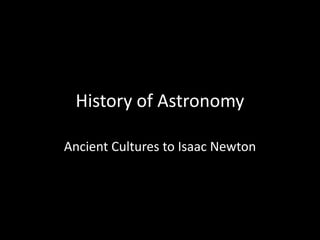History Of Astronomy (Thru Newton)
•Download as PPTX, PDF•
4 likes•1,597 views
Report
Share
Report
Share

Recommended
Recommended
More Related Content
What's hot
What's hot (20)
2018 2019 geocentric theory model vs heliocentric theory model revised

2018 2019 geocentric theory model vs heliocentric theory model revised
Viewers also liked
Viewers also liked (20)
Similar to History Of Astronomy (Thru Newton)
Similar to History Of Astronomy (Thru Newton) (20)
Q2 law-week-1-2 physical science-validated-converted

Q2 law-week-1-2 physical science-validated-converted
More from Oyster River HS
More from Oyster River HS (13)
Recently uploaded
Recently uploaded (20)
Strategies for Landing an Oracle DBA Job as a Fresher

Strategies for Landing an Oracle DBA Job as a Fresher
08448380779 Call Girls In Civil Lines Women Seeking Men

08448380779 Call Girls In Civil Lines Women Seeking Men
The Role of Taxonomy and Ontology in Semantic Layers - Heather Hedden.pdf

The Role of Taxonomy and Ontology in Semantic Layers - Heather Hedden.pdf
Raspberry Pi 5: Challenges and Solutions in Bringing up an OpenGL/Vulkan Driv...

Raspberry Pi 5: Challenges and Solutions in Bringing up an OpenGL/Vulkan Driv...
Powerful Google developer tools for immediate impact! (2023-24 C)

Powerful Google developer tools for immediate impact! (2023-24 C)
2024: Domino Containers - The Next Step. News from the Domino Container commu...

2024: Domino Containers - The Next Step. News from the Domino Container commu...
Strategize a Smooth Tenant-to-tenant Migration and Copilot Takeoff

Strategize a Smooth Tenant-to-tenant Migration and Copilot Takeoff
Presentation on how to chat with PDF using ChatGPT code interpreter

Presentation on how to chat with PDF using ChatGPT code interpreter
From Event to Action: Accelerate Your Decision Making with Real-Time Automation

From Event to Action: Accelerate Your Decision Making with Real-Time Automation
Workshop - Best of Both Worlds_ Combine KG and Vector search for enhanced R...

Workshop - Best of Both Worlds_ Combine KG and Vector search for enhanced R...
Boost PC performance: How more available memory can improve productivity

Boost PC performance: How more available memory can improve productivity
Understanding Discord NSFW Servers A Guide for Responsible Users.pdf

Understanding Discord NSFW Servers A Guide for Responsible Users.pdf
Automating Google Workspace (GWS) & more with Apps Script

Automating Google Workspace (GWS) & more with Apps Script
Axa Assurance Maroc - Insurer Innovation Award 2024

Axa Assurance Maroc - Insurer Innovation Award 2024
History Of Astronomy (Thru Newton)
- 1. History of Astronomy Ancient Cultures to Isaac Newton
- 2. Early Civilizations A practical approach Predicting seasons Navigation
- 3. Aristotle and the Greek View: Geocentric Model Geo- Earth Centric- Centered The earth is a motionless sphere at the center of the Universe. Explained the apparent motion of the sun, moon and stars.
- 5. Planets Greek astronomers observed that certain celestial objects do not follow a predictable path like the moon, sun, and stars. Called these objects Planets (Greek word planetes means wanderer) The observable motion of Planets is that they change speed and even loop back and forth relative to the stars.
- 6. Retrograde Motion Motion of planets in “backwards” or westward loops is known as Retrograde Motion.
- 7. Ptolemy (140 A.D.) A more complex model of the Universe/Solar System was needed to explain Retrograde Motion. Ptolemy suggests that planets orbit the Earth in a large circular orbits but also follow a small circular orbit around an imaginary point. These small orbits were known as Epicycles
- 8. The Copernican Revolution: Heliocentric Model Ptolemaic Model survived for 13 centuries Copernicus suggested that the Earth is a planet and spins on its axis and orbits the Sun. Heliocentric- Sun Centered This accounts for the apparent motion of the sun and stars. The realization that Earth is not at the center of the universe is now know as the Copernican Revolution. What about Retrograde motion of the planets?
- 9. Just like when you pass another car on the highway.
- 10. Galileo Galilei Used the telescope to view objects in the sky (1609). Observations of celestial objects supported the Heliocentric Model of the solar system.
- 11. Galileo’s Observations The terrain of the Moon, Sunspots, the moons of Jupiter Phases of Venus
- 12. Johannes Kepler A student of Tycho Brahe, Kepler used the precise data of his mentor to develop three simple laws that describe the motion of planets.
- 13. Kepler’s Laws of Planetary Motion The orbital paths of planets are elliptical with the Sun at one focus. An imaginary line connecting the Sun to any planet sweeps out equal areas of the ellipse in equal intervals of time. The square of a planet’s orbital period is proportional to the cube of its semi-major axis.
- 14. Kepler’s Laws certainly describe the motion of planets around the Sun but they tell us nothing about WHY planets orbit the Sun. What prevents the planets from flying off into space or from falling into the Sun?
- 15. Isaac Newton Described the basic laws of motion in what is now known as Newtonian mechanics. Newton’s 3 Laws of Motion. The Law of Universal Gravitation
- 16. Newton’s Laws Inertia: An object in motion stays in motion, an object at rest remains at rest, unless acted upon by a force. F = ma To every action there is an equal and opposite reaction.
- 17. Universal Gravitation Every particle of matter in the universe attracts every other particle with a a force that is directly proportional to the product of the masses of the particles and inversely proportional to the square of the distance between them.
- 18. Gravity: Why we orbit the Sun.